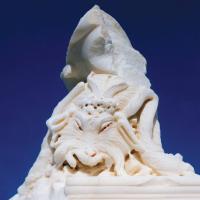Small statue of 'Marsyas'
Comment
The two marble fragments were discovered in the course of illicit digging at a field located on the western side of the Moḥammad Ābād road in the vicinity of the mound of Tal-e Ḵandaq (district of Borāzjān). Mehdi Rahbar interpreted the sculptural remains as belonging to a statue of the satyr Marsyas. (See Rahbar 1999 with pls. 1-3; idem 2008: 371, fig. 6a-b; Callieri 2007: 105-108, figs. 69-71, with additional remarks.)
When intact, the statue would have depicted a nude male figure provided with a tail and seated on a rock covered with a goat's skin. The figure's body would have been aligned with the longer axis of the rectangular socle of the sculpture, his head turned, as in a state of intoxication, toward the back. On the surviving fragment it has been possible to discern the figure's tail, thighs and genitals. Resting on the surface of the socle, on the right of the figure and in front of the goat's head, are the two reeds of an aulos (a double-reed pipe). Against the back of the rock seat, adjacent to the goat’s head, there is a lagōbolon (‘hare [hunting] stick’) and, next to it, on the left side of the figure, a syrinx ('Pan flute'). The statue’s various attributes evoke the circle of Pan. The proposed identity of the figure as Marsyas is based primarily on Marsyas' privileged association with the aulos in the Greek mythological tradition. The combination of iconographic details attested in this instance, however, does not appear to be canonical of representations of this satyr (Weis 1992). The composition was carved as one piece with the socle, the whole reaching perhaps originally ca. 0.50 m in height. According to M. Galli (Callieri 2007: 106), the color and crystalline texture of the marble likely point to a Greek island provenance.
The statue from Tal-e Ḵandaq, a work of excellent artistic quality, simultaneously displaying a close thematic affinity with the Greek world, was ascribed at first by Rahbar to the school of Lysippus and dated ca. 100 BC. Details of workmanship, in particular the frequent use of a drill and the contrasts of light achieved by modeling, were later argued by Pierfrancesco Callieri (2007: 108) to be compatible with developments in sculpture during the Roman Imperial period, more probably during the third century AD. According to Olga Palagia (personal communication), the use of the drill sets the carving of the statue during the Antonine period, in the second century AD.
This is the first (or, at least, the first published) archaeological artifact from the area of Būšehr that points conspicuously to the Greek world, and which might conceivably allude to the circumstances of a Greek presence locally.
In 1994-1995, excavations at the locality of the statue’s discovery by Ehsān (Esmail) Yaghmāee (Iranian Cultural Heritage Organization) brought to light foundations of structures of baked bricks within a mud brick architectural complex, which was interpreted as an ataškada (‘house/temple of fire’) and a Mithraeum from the Parthian and Sasanian periods (Yaghmāee 2015: 50). Archaeological materials of a similar chronological range, namely, from the Middle Parthian to the Sasanian period, were obtained from a further trench opened by Yaghmāee on the mound itself of Tal-e Ḵandaq in 1995 (Yaghmāee 2015: 58 n.2). Such findings would tend to support the notion of an original association of the statue of ‘Marsyas’ with a sacred locale, as also suggested by Rahbar (1999: 192), but they do not account in any specific manner for its presence in the vicinity of Tal-e Ḵandaq.
Broadly speaking, the association of a sculpture of Marsyas with a local religious environment might be especially warranted by testimony concerning the native traditions of the inhabitants of the hellenistic city of Antioch in Persis, which modern speculation often locates in the area of Būšehr (e.g., Talbert 2000: 94 A5). Epigraphic evidence (e.g., Rougemont 2012: no. 53, pp. 115-116; idem 2016) attests to the origin of a part of the population of this Antioch from Magnesia on the Maeander. As the small, rustic god Marsyas was prominently associated with Magnesia in legend and cult, one might reasonably expect that he would have also formed a part of the system of religious beliefs and observances brought by the Magnesian colonists to their new home city (cf. Bernard 1987). In this line of reasoning, the statue, which was found at Tal-e Ḵandaq and is currently dated to the Roman Imperial period, could offer testimony for a survival of hellenistic traditions locally long beyond the collapse (ca. 150 BC) of the Seleucid regime in Iran (Callieri 2007: 107). Attractive though it may be, this implication must be considered strictly hypothetical at least for the time being, since the location of Antioch in Persis in the vicinity of Būšehr remains unproven.
The statue's find spot is situated at once in immediate proximity to the Persian Gulf and on a principal route of communication between the Persian Gulf coast and the interior of Fārs. Considering also the statue's high quality and the proposed Aegean origin of its marble, the possibility may be equally left open at present that we are dealing with a Mediterranean import, one that was perhaps primarily appreciated in its new Iranian location for its aesthetic value as a work of art.
Bibliography
Bernard, P. 1987. 'Le Marsyas d'Apamée, l'Oxus et la colonisation séleucide en Bactriane.' Studia iranica 16.1: 103-115.
Callieri, P. 2007. L'archéologie du Fārs à l'époque hellénistique. Quatre leçons au Collège de France, 8, 15, 22 et 29 mars 2007. Persika 11. Paris.
Rahbar, M. 1999. ‘Pažuheš-i dar bāra-ye yak mojassama-ye marmari-e Yunāni az Borāzjān’ [‘A Greek marble statue from Borazjan, Fars’]. In Alizadeh, A., Majidzadeh, Y. and Malek-Shahmirzadi, S. (eds.), The Iranian World. Essays on Iranian Art and Archaeology, Presented to Ezat O. Negahban. Tehran: 28 [English summary], 192-207.
——. 2008. 'Historical Iranian and Greek relations in retrospect.' In Darbandi, S. M. R. and Zournatzi, A. (eds.), 1st International Conference, Ancient Greece and Ancient Iran: Cross-Cultural Encounters, Athens, 11-13 November 2006. Athens: 367-372.
Rougemont, G. 2012. Inscriptions grecques d'Iran et d'Asie centrale, avec des contributions de Paul Bernard. Corpus Inscriptionum Iranicarum, part II, vol. I.1. London.
——. 2016. ‘Que sait-on d’Antioche de Perside?' Studi ellenistici 30: 197-215.
Talbert, R .J .A. (ed.) 2000. Barrington Atlas of the Greek and Roman World. Princeton. A map-by-map directory is available online at http://press.princeton.edu/B_ATLAS/B_ATLAS.PDF
Weis, A. 1992. 'Marsyas I.' Lexicon iconographicum mythologiae classicae, vol. VI.1. Zurich and Munich: 366-378.
Yaghmāee, E. 2015. 'The Mohammad-ābād chārtāg, Dashtestān-Borāzjān.' Bāstānpazhuhi 9 no. 17: 50-58.
Cite this entry:
Zournatzi, A. 2016. 'Tal-e Ḵandaq: Small statue of 'Marsyas'.' In Mapping Ancient Cultural Encounters: Greeks in Iran ca. 550 BC - ca. AD 650. Online edition, preliminary draft release. Available at http://iranohellenica.eie.gr/content/catalogue/tal-e-kandaq/documents/1327759815







Small, fragmentary statue of 'Marsyas'. Vicinity of Tal-e Ḵandaq, Būšehr province, Iran. Roman Imperial period. Illicit excavation, 1992. Būšehr Office of the Iranian Cultural Heritage and Tourism Organization. Preserved H. 0.275 m (base: H. 0.043 m, L. 0.52 m, W. 0.295 m).